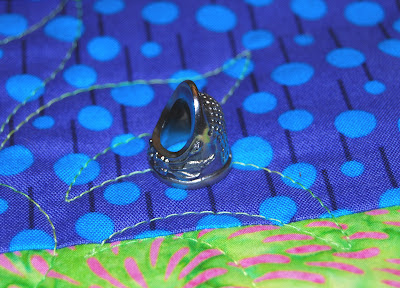The picture above shows my thimble, which I use for hand sewing my bindings, hand quilting (not that I do a lot of that, you know), pretty much any kind of hand sewing I need to do. This is a Roxanne Thimble, and it's the best thimble I have ever owned.
Before finding this one, I always had issues with finding thimbles that fit well and also lasted a long time. I never liked "traditional" thimbles, they didn't stay in place and just felt odd on my finger. Until I discovered leather thimbles, I simply sewed without a thimble and suffered the pain and torn skin on my finger. Leather thimbles were the first thimbles that I could tolerate. They fit well enough, but after time I would wear a hole through the leather and then I'd be back to wearing a hole in my finger LOL.
Then I heard about Roxanne Thimbles. I saw one in person, and I knew I had to give one a try.
I love the pretty details on the front and sides of the thimble. I also like that the front of the thimble is open and gives my fingernail room. That was a complaint I had about the "traditional" thimbles you commonly find, they were never all that comfortable... especially if I let my fingernails grow past the end of my fingertip.
I also love how many dimples there are on the back of my Roxanne thimble. No matter what angle I'm coming from, I can always find a dimple for my needle to rest in. I don't think I've ever had the needle slip on me while I'm sewing. The fingers on my other hand are thankful for that LOL.
And besides, it looks so pretty when it's on my finger! I've been known to forget that I have it on and wear it around the house LOL.
Now, if you're considering buying one of these, I will warn you that they are expensive. I got one of the silver plated thimbles (which is also the least expensive), and that currently sells for around $50. I know, that's a lot for a thimble... but if you do a lot of hand sewing or quilting, IMHO it's worth it. It is the last thimble you will ever need to buy.
They are sized like rings are sized, so you can pick the one that fits you best. While you can order one online, I would recommend that you find a local dealer that has some that you can actually try on to find the best fit. They're a good weight and feel fantastic on your finger, but they're not so heavy that they make your finger feel weighed down.
I hope you enjoyed reading about my favorite thimble. Now let's get back to sewing! :)















